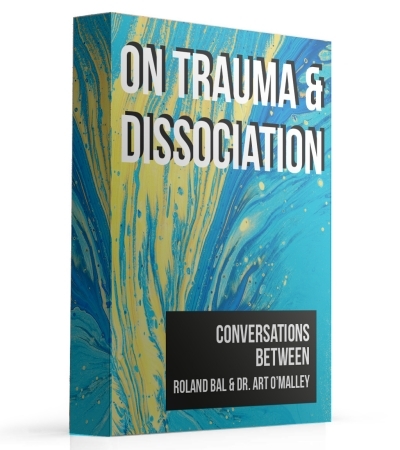Hereunder is the very first chapter of this new eBook.
Chapter 1: Dissociation Out of Survival
Roland: I'm here with Art O’Malley, who is a doctor in child and adolescent psychiatry. He has studied various other psychotherapeutic models, including sensorimotor psychotherapy and somatic experiencing.
Today, I wanted to see if we could talk about dissociation in general, and dissociation as a survival mechanism. In my approach, addressing dissociation is one of the pillars of resolving trauma, and there are various processes that are involved in dissociation. Basically, it's moving from embodiment through any kind of shock—either covering a period of time or a single incident—that we move into excessive thoughts, addictions, shutdown, and continuously overwhelming emotions. The dissociation that ensues happens on different levels and constitutes various fragmentations.
I've outlined these processes into a very simple structure which can be applied to any kind of trauma, be it severe or quite mild. With trauma, there's always a sense of feeling overwhelmed, a loss of control, and helplessness. That state of helplessness always relates to a particular core emotion, be it anger, sadness, or anxiety. From there, we dissociate further into what I call a coping emotion.
For example, you might lose somebody, somebody who is dear to you, so you have sadness as a core emotion. That sadness might be too overwhelming for you to hold, and so you fragment further through dissociation, and you might default to anger to deal with that overwhelming sadness. The sadness gets pushed away onto a deeper level and you stay more with the anger, which then expresses itself as feeling irritated or being very critical, being very judgmental, or self-righteous.
From there on, it dissociates even further into a substance or behavioral addiction like smoking or drinking, being obsessively occupied with work, or being glued to social media and technology. It could be anything, really; even yoga or going to the mountains could become addictive as a way of coping with excessive stress. I have met those people, who seem to do something very sporty and healthy, but they do it as a coping mechanism, and that fragmentation comes through at some point. I'm putting it very briefly now, as this is my way of looking at dissociation and trauma, but I'd like to go into it much more deeply with you.
Art: One of the ways I like to think about it is as a continuum. I give this analogy of if you're in the safari park and you come out and see a lion who maybe, say, is 200 yards away from you. Your body goes into alert state and everything is activated in terms of your body's response to that. You may gradually think, "I need to get back to the Range Rover to safety."
As that lion comes closer and let's say it's 100 yards, 100 meters away from you, your body becomes activated and very quickly goes into a decision: "Do I fight, do I flight, or do I freeze?" It's at this stage, when the lion comes closer, that in terms of a physiological response, the only way we can survive is to become very flaccid and to collapse and to become numb. That's very much the result of the activation of what we call the dorsal part of our vagus nerve, which is divided into both the ventral, which is the front of the body, and the dorsal part.
When that gets activated in order to survive and the lion is right up next to you, if you were to fight back or attack the predator at that stage, you could literally be torn apart; but if you're flaccid, and if you give in and play dead and literally dissociate, you might survive.
Sometimes, the only way that you can play dead is to physically and emotionally leave your body, if you like, so that you're no longer attached to it, and that may actually keep you alive. The difficulty for many people is in reclaiming the integrity of their state, their emotional or mental state. It can be something that's very difficult to cope with because they've never actually got away from the idea that they're still under attack, and they're still reliving this event.
Roland: Let me intercept you there and see if we can get deeper into that. You mentioned the fight, flight, and then the freeze response. It's almost like you're saying that the fight and flight response is, first, what gets your adrenaline going; there's danger, there's a response to danger by your physiological responses, and then when there's no completion of your fight-flight activation, because of the continuing danger, you default to freeze as an alternative in order to survive.
Do you feel that the way to work on that is to go back into that experience in a similar fashion? That first you have to be with the freeze response, and perhaps make links to what event or what period in your life it relates to, and from there on, once you hold that freeze response, the disconnection or dissociation, that you might feel your fight-flight response, which might be translated as extreme anxiety or hurt vulnerability.
How would you see that?
Art: That's a really good question because I sometimes see there's another type of freeze that I didn't mention. It's the freeze of the shock of the sudden potential danger where you're activated, but you're frozen at the same time. There's that hyper-aroused type of freeze as well as the frozen-shutdown type of freeze. The fight or flight can intermingle with those states. They're almost like two sides of the same coin.
I would say if you’re in the freeze state, you need to be activated a little bit to reach what most people would call their window of tolerance and in a state where you can think and feel at the same time, being careful not to tip into that fight or flight response or hyper-aroused response. When you're dealing with somebody who's processing, they can't do a lot of processing in either of those two states, which are both dissociations from the true self, really, and the true integrity of how they're processing.
I would see it as a juggling act and as a balancing act of recognizing which state they're in, and giving them the tools to get into and open up that window of tolerance because in a lot of these patients with this chronic experience of attack, they have not got the experience of having a very wide-open window, so they flip from the frozen state to the hyper-aroused state very, very quickly.
Roland: It's interesting that you mentioned that both are present and they're both part of a dissociation process or the fight or flight on one side, and then the freeze response on the other side. What I noticed is that people who have gone through trauma seem to be fluctuating between those two.
They're either too frozen and it expresses itself as depression, numbness, amnesia, chronic pain, or other physical and psychological symptoms that go with that. Then they go through periods where they're hypervigilant, they're hyperactive, racing thoughts, racing heart, all of these things together.
They go in between those two extremes and, exactly as you said, they're missing that level of tolerance, the resilience to actually integrate, going continuously back and forth from one extreme into the other. I would say the gluing between that seems to always be some form of judgment either towards themselves or towards others, which are the excessive thoughts.
I heard somebody else calling them "inhibitory responses," which is quite interesting as well to call them that. Anyway, this glue, the inhibitory or intermediary responses seem to be some form of blame, shame, guilt, self-reproach, embarrassment, comparison, pride, self-righteousness, and comparison.
Those are the glue that makes those responses of dissociation go from one extreme to the other. Now, one final thing I want to add before I give it over to you, is that the lack of a level of tolerance or resilience seems to be the prime contributor that keeps trauma in place; or, when there is enough resilience and tolerance, is what will help people actually move through trauma.
What also needs to be considered is how people go into a traumatic experience; the intensity and the duration of trauma, and then, lastly, the support they receive after the trauma.
Either you are able to move through a traumatic experience or period because you have enough support afterwards and the duration was somewhat contained and you went into it with a sane mindset, or the opposite. You're already being burdened by childhood experiences and you experienced an overall lack of support. The traumatic state has become chronic. It goes on and on and repeats itself through different experiences into adulthood.
I know we started talking about dissociation, so there are a lot of different elements here that we are bringing into the conversation.
Art: I wonder, do you agree that one of the core emotions that maybe has been repressed is this anger or rage that can be either frozen or trapped in the body? I find if you can activate their connection to those feelings, then some of the more subtle emotions can be felt and registered. One thing that I noticed recently with some of these responses to reactivating this trauma; I'm always very interested in how the body stores the information and where the body is registering that tension.
This person told me that she felt it on either side of her lower abdomen, and it just coincided, in my view, with where the adrenal glands are situated above the kidneys. We know that with depression, and we know that under stress, the adrenal glands will become hyperactive; they will increase in size, they will produce all of this adrenaline. Literally, that physiological state of activation has a massive impact, both on your physical health and your emotional and mental health.
You can reverse that by tuning into it and helping that inflammation, that enlargement to decrease. It helps us, I think, to integrate these responses and realize how they're driven very much by the endocrine system, the immune system, circulatory system in ways that we don't fully understand or control at the time.
Therefore, in the therapeutic process, you can educate and reverse those processes in a safe way.
Roland: This makes it interesting in that both of us have a body-oriented approach and that we take on board the body's responses to stress and trauma; and that tracking the sensations, the emotions, and the thought processes actually sets in motion physiological changes, and potentially rewires the brain and nervous system.
Art: I do too.
Roland: There are certainly limitations—regarding recovery—and I think it is important to have healthy expectations. That said, I have seen people who have been severely traumatized and they have recovered 50%, or 60%, or 70%. That is a major leap of improvement in lifestyle and life quality.
Art: I think, in the way that I work and in the way that you work as well, my goal is always that they leave each session feeling unburdened, feeling the symptoms of their trauma less intensely, and almost like they have a weight lifted off their shoulders that has been literally pressing down on them, holding them back. In a session that I usually do, which are ideally an hour and a half to even two hours long, there's time to rewire those networks and then to allow the information to percolate at a thinking level into the thinking part of the brain.
It's almost like when the trauma happens, the reptilian brain, the primitive structures of our spinal cord decide that in order to survive, our heart, our lungs, our guts, they need to get the most blood supply because they're going to be crucial to our survival as a species. The head, if you like, is considered redundant. In a sense, I'm just thinking as we're talking that the head at the moment of the trauma dissociates from the rest of the body because the reaction time of the cortex is about half a second, 500 milliseconds, where the body will be responding within 30 to 40 milliseconds.
That knowledge, and intrinsically your neural system, gives the head less of a role to play in the immediate response to survival. Though, I find that one of the goals of my therapeutic process is to connect with where that information has been stored on a physiological level in the body and then to titrate it and activate it so we reverse that process, so we can give patients the sense that they're no longer in danger and it's safe to reperfuse their brain. Then at the end of the session, I say, "Well, what have you learned? What meaning, if you like, does the experience hold for you now?"
They're able to contemplate in a way that they wouldn't have been able to do before because the networks are now being perfused, the synapses are connecting in a way that wasn't possible, or wasn't visible, or wasn't even advisable at the time of the trauma happening.
Roland: There's also what I have coined the "please response."
Art: Yes, that's interesting.
Roland: Some call it the "fawn response". We pretend to get approval, to get acceptance, to get some sense of self, even if it is through externalization. I think pleasing is especially present when we talk about developmental issues, or traumatic environments that persisted for years, and that response goes alongside the fight-flight-freeze responses.
I work with a lot of people who have symptoms of complex trauma, and they have various traumatic patterns that relate to different people; so, if they relate to their dad who might have been the abusive person, they have a different set of reactions, of survival, with their mother, who might have been the neglectful person.
With one parent you're either more fight-freeze and the other parent, you might be more flight and please. So, with the fight response it relates more to being angry, getting upset, being irritated, while a please might be more being submissive, allowing too much and having your vulnerability and your boundaries crossed.
It becomes more complex through different traumatic experiences, different situations, and people. You have various survival patterns that are built in different parts of the brain, like, "With this person, I need to react in this way to survive and with that person, I need to react in that way." It takes up a lot of energy to have various sets of survival patterns related to different people, and they can activate and get triggered so unconsciously.
Even to become aware of those patterns that we have, that as a patient, you have, can take a lot of time. A therapist, of course, helps you with speeding up that process, the cognitive understanding. As you mentioned, a therapist and patient, they're actually working through those processes, of renegotiating, what I call boundaries and vulnerability. Going from the dissociation into the activation and then going into finding that point of resilience where you can contain and not be moving into extremes all the time, and bring some resolution, physiologically, mentally and emotionally.
All of that goes together, of course, as you know.
Art: I was interested in your work online with patients who have dissociation. You are able to tune into them and cut off a potential dissociative response by being aware of their states of mind as you're dealing with them and just distracting them or turning to mundane topics.
Roland: Changing the topic for a while, yes. I often use that; it's a nice technique to shift the attention onto something more mundane, especially when your client starts to get too focused on the internal pain. Like, "Okay. What kind of books are you reading or what's going on your life or what's next after the session, what are you up to? How is your house looking, does it need repairs or what do you need to do today?"
Just little things, simple things that take their minds off from the freeze response, when they stay too long in there. I think you need to do that as a therapist, and it takes practice to come to that point that you can just shift the attention naturally, easily, and move it into a different energy.
As a therapist, the first time is like, "What do I do with this?" because it has that stagnant energy, and at first you can get pulled into that freeze response, especially if you haven't worked on your own things sufficiently enough. I think through experience, you know how to first recognize it and then to shift the energy and gently move out of there.
Art: One thing I'd like to share with you when we have the time is, it builds on the work that I wrote about in the book that came out a few years ago, where I had a picture of the rapids, a picture of a castle, and then a picture of a sort of frozen lake. I've since had that developed as a three-dimensional model, just quite a small little box that's a wooden box and in the center is a cardboard model of this castle with a number of windows down at the bottom.
There's a picture, a three-dimensional model of the rapids for the person who has racing thoughts, affective instability, their personality is fragmented into parts, they're impulsive, distressed, and suicidal. Then on the opposite side of the castle, the frozen lake represents this freeze reaction where they're oblivious, and they're emotionally numb. As I said, they can be two parts of the same coin, but the castle has an open roof, if you like, where they can feel safe and contained and can, through imagination and guided visualization, get a safe space where they can contain the emotions that they had.
One patient was able to actually, without me saying anything, draw a picture of a door and of herself holding a key, which gave her the ability to escape from the emotions to a path where there would be therapists who she knew to interact with and relate to, and her partner as well, which was a bit of a breakthrough and what we described as a light-bulb moment for processing these emotions that had been repressed and held on to for a long time.
Roland: Excellent. I think it would be good for today to end it here and use our follow-up meeting to go into the next part on trauma and dissociation.















